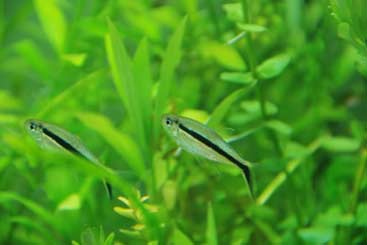
Tetras
A GUIDE TO CARING FOR TETRAS

Tetra’s are among the most common and popular tropical fish. This is due to their small size, calm temperament, low cost, hardiness and strong colorations.
Tetras are very easy to care for and can be housed with almost any other non-agressive species. The small size and nature of Tetra fish often means they will school together in the aquarium. This is a desirable trait in freshwater species and can add a brilliant effect to any large aquarium.
There are countless species of tetra. The most common aquarium additions include Neon Tetra, Cardinal Tetra, Penguin Tetra, Harlequin Tetra, Rummynose Tetra, Glowlight Tetra, Ember Tetra & Glowlight Tetra. These species have excellent colorations, lively personalities and are less sensitive to water conditions than other fish. They have a maximum size of 2" and can live up to 10 years in captivity if properly cared for.

Temperature ~74°F
- The optimum aquarium temperature for Tetras is around 72°F - 78°F (22°C-26°C). When housed with Discus at 80°F+ Tetras will generally have a higher metabolism and become stressed more easily. Their life span will also become shorter.

pH ~6.5 | Hardness 6.0
- Keep your pH between about 5.5 and 7. Tank bred Tetras may accept lower or higher pH depending on the store water parameters. Be sure to check this when purchasing.
- Relative water hardness should be 4kH - 8kH. This will replicate relatively soft conditions similar to the amazon.

Max Size ~2"
- Both males and females can grow to around 2".

Nitrite 0ppm
- Nitrite should always be 0.

Ammonia 0ppm
- Tetras are sensitive to ammonia spikes. They may lose color and breathe rapidly.

Nitrate >40ppm
- Nitrates should always be as close to 0ppm as possible. Any reading under 40ppm is suitable for keeping Tetras. Elevated levels can be reduced by adding aquatic plants and increasing the number of water changes.
Purchasing Tetras
Tetra species are originally South American streams including the Amazon. This explains their need for softer water conditions and lower pH. Although tank bred varieties will tolerate elevated levels of pH or dH, lowering these will help them thrive.
A few species of tetra like the Congo Tetra tend to be more aggressive and are best kept in a species aquarium. Discuss stocking options with your local fish store and mention your concerns about compatibility before making any purchase decisions. An excellent, reasonably priced tetra to trial as your first tropical fish is the neon tetra. These are easily identifiable by their bright red and neon blue stripes. They are usually around $1 each and even less when purchased in a school.
Tetras are best purchased as a school of at least 3 to 4 of the same species. This will help make the fish more secure in the environment and less stressed.

Adding the Tetras
- Ensure the aquarium has been cycled and chemically tested. Try to ensure that the readings are within the parameters listed above.
- Float the unopened package or plastic bag in the aquarium for 5-10 minutes. This will allow the water in the bag to increase to the same temperature as that in the aquarium. The bags should be filled with oxygen meaning there is little risk of leaving the fish sealed for a while longer.
- After 10 minutes cut open one side of the bag. Slowly pour one cup of water from the aquarium into the bag and let it sit for 5 minutes. Continue this process for 3-4 cups of water, you may need to clip or wedge the bag to the side of the aquarium to prevent it falling over.
- Use a soft net to collect the Tetras from the bag and gently place them into the aquarium. Dispose of the fish store water from the bag. This method will improve the survivability of your Tetras dramatically.

Feeding Tetras
- For maximum health and coloration of Tetras it is recommended to feed them varied diet of processed and frozen or live foods. Tetras enjoy a variety of flakes or very small granules. Live or Frozen Bloodworms in a small feeder cone are an excellent treat for adult Tetras.

Breeding Tetras
- Unfortunately breeding tetras in captivity is extremely difficult and poorly documented. Below are some basic steps to help you toward the process of breeding tetras.
- Purchase a large brood of at least a dozen young tetras. The younger tetras have a much lower chance of disease, sterility and contamination. They have also spent a larger amount of time in your aquarium and will adapt to subtleties in the water column.
- Maintain perfect conditions for the tetras. Sterility is the biggest problem with many species of fish, including tetras. In poorer conditions breeding is a much lower priority for Tetras who will focus on survival.
- Feed the Tetras a varied diet of flakes, granules, frozen and freeze dried worms and of course live worms and shrimp. Ensure you feed the stock twice a day to keep the Tetras at optimum health and virility.
- Pair the Tetra's by looking at the subtle difference between male and female. Females are generally slightly larger than the males, with shorter dorsal fins and less saturated colors. Males are more slender and often have extended fins and rays. They often have a brighter and more saturated color.
- Pairing and courting is the hardest part of breeding Tetras. Be noble in defeat but do not give up. Consistently try new pairs in the breeding tank until you find a successful breeding pair.
- Insert a fine leaved plant or floating moss into a small 5 gallon breeding tank. Ensure the water is very soft and at a stable pH similar to the display tank. Place a breeding pair into the aquarium and monitor their progress. Generally Tetras spawn in the early hours of sunrise. You will notice the plant lined with very faint black dots that are in fact Tetra eggs.
- If successful remove the parent fish and feed live infusoria to the fry when they hatch anywhere from 12-48 hours after spawning. Eventually upgrade to newly hatched brine shrimp,nauplii and microworms. Once the fry are big enough feed them powdered flakes. Congratulations if you get to this point, breeding Tetras is extremely difficult.


